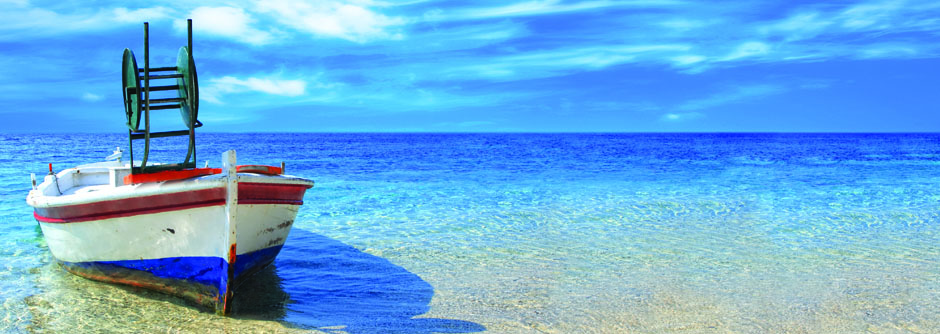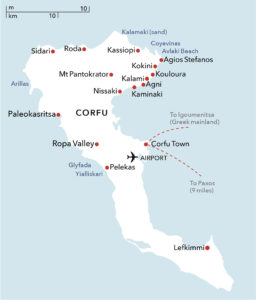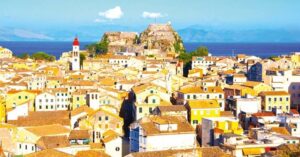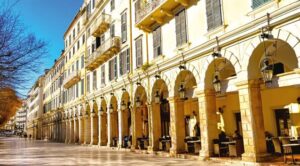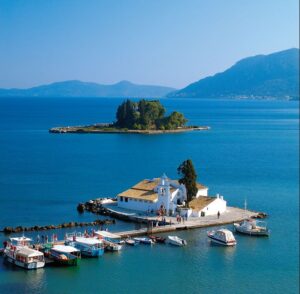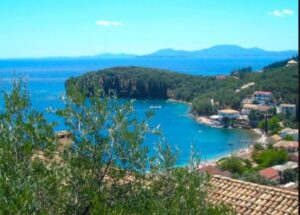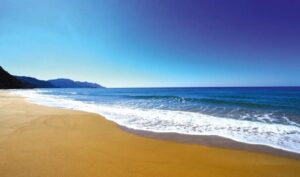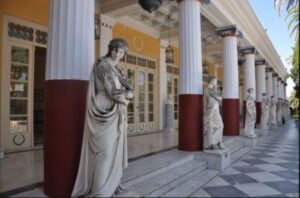The rich and varied island of Corfu offers a host of opportunities for those with an interest in the more active pursuits such as walking, swimming, cycling, horse riding or water sports. It has a varied and lively nightlife, and it’s also a perfect place to just sit by the pool, on the balcony or on the beach doing absolutely nothing!
Being the most northerly of the Ionian Islands, Corfu experiences high annual rainfall resulting in a wonderful year-long array of wildflowers and vegetation. Said to be one of the greenest of the Greek islands, Corfu boasts a wide and colourful variety of fruits, nuts and vegetables. Lemons, oranges, kumquats, grapes, olives and fennel grow in abundance.
When combined with the scents of wildflowers they make a wonderful aromatic cocktail!
Corfu town of ‘Kerkyra’, the island’s capital, combines elegance and sophistication with tradition. A maze of beautiful back streets opening out here and there into little ‘plateias’ (squares) lead us into the heart of the old town with its smart shops and cafés; a joy to explore day or night.
A BRIEF HISTORY
Since ancient times, Corfu has been known as a place of beauty, culture and hospitality. In his ‘Argonautics’ Appolonius of Rhodes mentioned that Jason and the Argonauts took refuge in Corfu to evade the pursuing Colchs. In ‘The Odyssey’ Homer describes how Odysseus was cast ashore and discovered by Nafsika, daughter of King Alcinoos at a time when the inhabitants were of Phaecean origin. Even Alexander the Great, charmed by the beauty of the island, gave it his protection for some thirty years during the 3rd century B.C.
The island’s situation on trade and invasion routes to and from the Balkans and the Levant, has given Corfu her fair share of troubles.
Between 735 – 435 B.C. under the Corinthian political system, Corfu became a vigorous power with a strong naval and economic force, thriving peacefully for 300 years until Corcyrans came into conflict with Corinth itself. Athens sided with Corfu, a move that sparked off the Peloponnese war.
There followed a time of changing fortunes. Corfu became part of an Athenian alliance and subsequently fell into the hands of Philip of Macedonia (Alexander the Great’s father), Sparta, cv Syracuse and Illyria before being ceded to Rome in 229 B.C.
The first Greek territory to fall under Roman rule, Corfu, supplied Rome with men and ships for its wars and despite persecution, Christianity was introduced. In 337 A.D. the Roman Empire split and in 395 Corfu was ceded to the Byzantine Empire.
Corfu remained nominally Byzantine for eight centuries, and there is still evidence of the occupation here, particularly in churches and church paintings. Being one of the most distant outposts of the Byzantine Empire, it was, however, constantly subject to raids by Vandals, Goths (led by Totila, an event which led to relocation to the ancient city for defensive purposes to the old fort), by Saracens and Normans, various Frankish Knights and the Venetians. In 1214 with Byzantium once more in control, Corfu became part of the Desperate of Epirus, at that time one of the three independent Greek states.
The use of the Greek language in the Byzantine Empire led to the church splitting from the control of the Pope and coming under the auspices of the Patriarch in Constantinople. The Greek world opposed the Latin and so the Orthodox faith was born.
In 1267 The King of Sicily seized the island and divided it into the four bailiwicks, Gyros, Oros, Mesis and Lefkimi. Then, following increased and constant threats from Turkey the Council of Corfu asked for the protection of Venice. So it was that on 20th May 1386, the flag of St. Mark was raised on the Old Fortress and was to remain there until 1797.
The four centuries of Venetian rule determined the character of Corfu as we know it today. The Italians offered security but in return demanded total submission. Architecture, music, folklore, even dialect reflect their 370-year presence. They encouraged the planting of olives and developed the agriculture of the area and, for the privileged, they brought with them a rich cultural life. Despite the strength of the Venetians, Corfu was still the subject of repeated attacks by Genoese pirates and the Turks; this constant fear is one of the reasons the oldest villages are to be found high in the mountains often invisible from the sea, and not easily accessible over land.
In 1797, Napoleon conquered Venice and recognising how important the Ionian islands were, sent a French Fleet over. At first the French were welcomed, the locals fired by the ideas of the French Revolution and eager to gain liberation from the ‘cultured’ but repressive Italians. The French however, proved no less authoritative and their rule was short-lived. In 1799, Corfu was taken by the Russians and Turks, concerned by French territorial expansion. Under Russian protection, Corfu and the other Ionian islands joined to create the independent Septinsular Republic, where aristocracy was given total control, almost leading to civil war between merchants and peasants.
In 1807, Tzar Alexander ceded the islands back to Napoleon. During this second period of French rule, the Ionian islands’ school system and printing presses were established. The ‘Liston’ was also built along the same lines and at the same time as the Rue de Rivoli in Paris. Napoleon was defeated in 1814 by the British and the last notable period of civic construction began. The Palace of Saint George and Michael, the Ionian Academy and Mon Repos as well as other amenities were built.
The high commissioner, Sir Thomas Maitland, nicknamed ‘The Abortion’ by the Greeks, was seen by many as being dictatorial and denying any political role for Corfu’s educated and middle class. He did, however, help rebuild the economy of the island and for the first time the islanders could afford to build much needed roads, aqueducts and other public works.
The Ionian Academy, the first Greek University, was established and most importantly, Greek became the official language. The British remained in Corfu until 1864 when Queen Victoria offered the Ionian islands back to Greece. There is a monument of this union in the park near the bandstand.
During World War II, Corfu was occupied by the Italians and Germans and was severely bombed by the Germans, destroying several of the most distinguished building, including the Ionian Academy, library and the Municipal Theatre (a theatre that rival la Scala). Most, if not all of the town’s large Jewish population who had found refuge here over the centuries were arrested and shipped off to Nazi camps. Immediately after the war, Corfu shared the fortunes of Greece racked by civil war and poverty resulting in mass emigration. This trend continued until the 1960’s and 1970’s when development in tourism gave a new impetus to the economic and social life of Greece.
The island’s attractions to tourists was already evident by the turn of the century. It was on the lists of those who embarked upon the ‘Grand Tour’
– including Lord Byron, and it was the spot chosen by the Empress Sissi for her Achilleion Palace – built in 1890 as a refuge from the intrigues of the Hapsburg Court. Through the years the island’s natural beauty, wonderful beaches and elegant architecture have attracted more and more people, including of course the Durrell family, who made Corfu their home, immortalizing the island in their writings.
By the 1960’s the “delectable landscape” of Corfu had attracted some of the first of the ‘mass market’ tourists to visit Greece. Sadly, many seaside villages and beaches quickly turned into not particularly attractive ‘resorts’. This gained Corfu a tainted reputation that she most certainly does not deserve. These ‘black spots’ are few and far between and if you venture even slightly off the beaten track you will find an island brimming with history, culture and beauty.
CORFU TOWN
No visit to Corfu is complete without a trip to the island’s capital. Said to be one of the most vibrant and cosmopolitan areas outside Athens,
Corfu town is an absolute delight. Undoubtedly chic and trendy, it comes as a wonderful surprise when you venture beyond the facade of the elegant esplanades and squares, beyond the sophistication of the café bars and the modern shops and into the Old Quarter – a labyrinth of narrow cobbled streets, lanes and alleyways overshadowed by tall 18th century buildings.
The Venetian influence is certainly strong but the French and English styles are also much in evidence. The Parisian style Liston is an ideal spot at which to enjoy a drink – its prime position in the town providing ring side seats for watching the well-heeled on their daily ‘volta’.
The Palace of St. Michael and St. George is regarded by some as the finest example of the Regency style outside Britain. And let’s not forget the other great British legacy – the cricket pitch!
KAVOS
Despite its reputation as a party resort, Kavos on the south coast, remains at the very least the resort with everything and probably one that the kids will love – especially if they want a change from Greek salads and souvlaki! As well as loud music there are watersports, bungee jumping, and so on. There is also a good beach here.
KASSIOPI
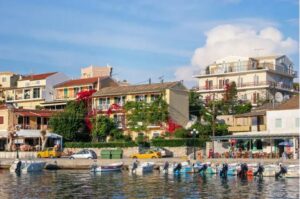
Fishing boats and Taverna’s line Kassiopi Village
Kassiopi, where the Roman Emperor, Tiberius had his holiday home, is now a bustling resort with good shops and supermarkets, a ruined castle, and five pebble beaches. There is a wide choice of international cuisine available here, from Mexican through to Chinese, as well as some very good traditional Greek tavernas, of course!
LEFKIMI
Lefkimi on the southeast coast is the island’s second largest town and an alternative ferry port for the mainland and Paxos. Despite its close proximity to the major resort of the south of the island, this is a truly traditional Greek town with shaded plateia, interesting churches, and a refreshing lack of development.
In spite of the presence of the busy port, there is just one café serving the lorry drivers awaiting the boats. Likewise, the shops in the town are very much unaffected by tourism and you can find many everyday items in the range of shops available.
PELEKAS
The magnificent hilltop situation of this pretty village retains much of its original charm. Kaiser Wilhelm even built his famous ‘Throne’ – a small viewing tower on top of this wooded mountain – so that he could admire the dramatic western coastline and its stupendous sunsets.
BENITSES
This resort on the south coast suffers from a slightly notorious past but is undergoing something of a quality change and reestablishing its traditional roots. The north end of the village is much quieter and more interesting, with a rather unusual shell museum boasting more than 2000 shells!
There are also some limited Roman remains. Just south, though, despite the other highly developed resorts, there are a few little gems such as: Ano Moraitika and Boukari.
KANONI
Bordering Corfu town, Kanoni is where you fill find the much-photographed monastery of Vlacherna and Pontikonissi (Mouse Island). What the pictures don’t show you is that these are immediately next to the airport runway. Nonetheless, it is a beautiful spot with a little boat making trips across to the island with its tiny church.
AGIOS MARKOS
This pretty little village is situated just above Pyrgi on the east coast. The snack bars – including the one that sells ‘local moonjuice’ – offer fantastic views out beyond the resort of Ipsos.
The pretty 17th century Church of St. Mercurios is the oldest Byzantine church in Corfu, and at the top of the village, the interior of the 17th century Church of Pantokrator is almost entirely covered in frescoes.
SPARTILAS
On the same stretch of coast, a detour to the village of Spartilas will again give great views across Corfu town as well as a lesson in driving carefully on Greek roads. The bar in the colorful square proffers some the best local wine you will taste in Corfu. Continue through this little village and you will find yourself high in the mountains. Blissfully peaceful even in the summer, the road to the top of mount Pantokrator or across the island towards Paleocastritsa gives startling views around every bend and eventually takes you out onto the Northwest of the island with its maze of traditional villages and some beautiful wide sandy beaches.
NISSAKI
Nissaki is one of the few areas in Corfu that has, despite an increase in tourism, retained its original charm and character. The small beach of Nissaki village does get busy during the summer months but it’s served by good tavernas and has a new watersports jetty, certainly worth a visit.
The beach at the Nissaki Beach Hotel has snack bars and watersports but should not be confused with the first beach.
KAMINAKI
A tiny hamlet nestling beneath the shadow of Mount Pantokrator, picture postcard material when viewed from the sea with a sweet pebbly beach a couple of tavernas and a small selection of watersports.
KALAMI
The whole of the north-east coast of Corfu is affectionately known as Durrell County and it is here at Kalami that Lawrence Durrell wrote his book ‘Prosrero’s Cell’. Since his day Kalami has changed into a fairly bustling quaint resort but is still one of the prettiest bays along the coast and the ducks at The White House offer some insight into how totally unspoilt this area once was.
KOULOURA
Viewed from the top, Kouloura is a charming circular harbour, still totally unspoilt and tranquil. This tiny hamlet boasts just one taverna and no shops or holiday accommodation and is a perfect place to unwind.
The gracious house on the headland is privately owned by an Italian family and dates from the 17th century. Architecturally interesting, the house is part mansion and part fortification, this area of Corfu being strategically important in times of trouble.
KERASIA
Kerasia is a long stretch of unspoilt beach with just one beachside taverna and pedals to rent. A wonderful quiet and ‘get-away-from-it-all’ location.
TOP BEACHES IN CORFU
DAFNILA & DASSIA BEACH
These are popular beaches backed by olive groves – Villa Mimbelli, a replica of a 14th century Italian palazzo, is to be found nearby.
KONTOKALI BEACH
A 30-minute walk or a short drive along the coastal road from Gouvia, these two sandy beaches are situated on either side of the peninsula. They are child friendly and watersports, sunbeds and parasols are available.
AGIOS GEORGIOS
A little further south along the coast from Agios Stephanos, this is the best place to go for windsurfing, with a large sandy bay and plenty of space. Board hire and instructions are readily available. There are a number of excellent fish tavernas by the waterfront and a couple of bars, but the resort is essentially very low key.
KALAMI, KOULOURA & AGNI
This part of the coast is broken by a series of picturesque bays, each with its own small, quiet, fishing village. The main road is forced by the steepness of the terrain to follow a course set back from the sea, with access to these villages by winding lanes. Between the villages are a host of small coves accessible by path or track, which remain uncrowded even in the height of summer. The numerous waterfront restaurants provide a wide choice of menu with fresh fish very much to the fore.
KORISSIA LAGOON & HALIKOUNA BEACH
Situated along the southwest coast of the island, the Korissa lagoon is in fact manmade, dating back to the Venetian occupation of the island.
Now a nature reserve, the lagoon is 5km by 1km, and is a peaceful sanctuary where turtles, tortoises and many species of migratory birds
can be seen. On its seaward side is the long and almost deserted Halikouna Beach, with its small taverna. It is a gorgeous stretch of sand backed by wind-blown dunes.
GLYFADA
Another popular resort in a beautiful location, a fine beach with dramatic cliffs on either side. The excellent beach here is probably best visited outside of peak season, as it gets very busy. There is a small selection of tavernas in Glyfada, and a bar.
AGIOS GEORGIOS – SOUTH
This is one of the longest beaches on the island, almost encircling the entire Korissia lagoon. Popular with package tours, it is worth a visit for its selection of good restaurants offering a wide range of international cuisine and a vibrant nightlife. Next to Agios Georgios there is also the beautiful Issos beach.
ERMONES
Ermones, on the west coast, has a fantastic beach with a number of facilities available. There is even an 18- hole golf course nearby.
TOP PLACES TO VISIT IN CORFU
THE ESPLANADE
Running between the town and the Old Fort, the Esplanade is one of the largest squares in Greece as well as being home to its one and only cricket pitch. Lined on the western side by the Liston building and at the northern end by the Palace, the Esplanade is adorned with monuments – including the Rotunda built to commemorate.
Sir Thomas Maitland, now used as a bandstand – where concerts are often performed by the local bands during the summer months and a monument commemorating the union of the Ionian islands with Greece in 1864.
THE OLD FORT
Built on high land by the Italians and surrounded by a moat, this spectacular fortress was part of the towns immense battlements that formed a huge starlike defense system all around the town. The strategic position of the Old Fort was instrumental in holding out, in particular against the Turks in 1716 but also against many other endless marauders that tried through the years to take the island. When the Italians left it served for a time as the barracks for the British, who built the Church of St. George on the site and now it houses the towns archives, a small Byzantine Museum, the music department of the Ionian University and
a very nice café! Although it’s a steep climb, the views from the old lighthouse at the highest point are well worth the effort.
ACHILLEION PALACE
Situated just south of Corfu town on the main road to Benitses, the Achilleion Palace is an impressive house open to the public daily and thus attracting a number of coach tours throughout the day.
Don’t let that put you off, however, as the palace is definitely worth a visit. Dating back to 1890, it is home to a number of portraits, jewelry, displays and personal effects of Elizabeth, Empress of Austria. She originally had the house built as
a summer retreat and named it after Achilles, reflecting her passion for Greek literature and mythology. She would visit every summer until her assassination in 1898 by an Italian anarchist. Elizabeth was the much-loved queen of Hungary and the Empress of Austria, whose tragic life is well documented and was even made into a film in
Austria, ‘Sissi’ (her nickname), in the 1950s. After her death, the palace was abandoned for a while and then taken over and used as a hospital toward the end of 1919, during which time some of the original artwork, furnishings, and interior were damaged.
Fortunately, however, most survived and in 1962 the palace became part of the Greek National Tourist Organisation. It is open from 9.00am – 7.00pm.
MON REPOS
A ‘Royal’ villa built in 1831 for the second British High Commissioner, Sir Frederick Adam. It was later handed over to the Greek royal family and still, theoretically, belongs to the exiled King Constantine. The grounds of this mansion have recently been opened to the public amidst much debate and the house is now used as a conference centre. Archaeological digs have established that Mon Repos is built on the site of Ancient Corcyra (Corfu) and at present the Kafsiki dig is continuing.
THE BRITISH CEMETERY
The British Cemetery is the final resting place for those who died here during the British Protectorate and the two World Wars, as well as
some civilians. It is tranquil and beautifully kept and home to over 30 rare species of orchid. George Psaila, who has looked after the Cemetery since 1944, was recently awarded the British Empire Medal in recognition to his dedicated work.
CORFU TOWN HALL
Built in 1663, the Town Hall is a splendid example of Venetian architecture. It began life as a meeting place for nobility, was transformed into a theatre, and then an opera house. The recently re-vamped Town Hall square is a lovely place to sit for drinks, although you do pay for the privilege.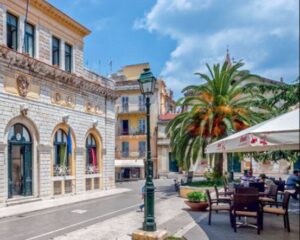
VILLA ACCOMMODATION IN CORFU
We have a complete offering of fabulous accommodation options on this island which offers so much and still has many untouched areas where you go off the beaten track.
For more information on this region and to help you with which accommodation options you can book please call our team on 0208 459 0777 or mail@ionianislandholidays.com.
